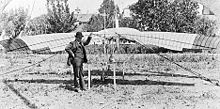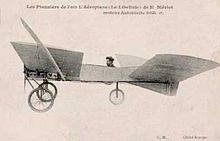Tandem wing


A tandem wing is an arrangement of two similarly sized wings one behind the other on each side of the fuselage of an aircraft . This arrangement has rarely been chosen in the history of aviation . One of the first machine-powered aircraft, the unmanned Aërodrome No. 5 by S. Langley , which flown about 1,200 meters on May 6, 1896, was a tandem wing model.
functionality
One of the golden rules of aerodynamics says that for a stable flight the part of the total horizontal surfaces flying ahead must provide a higher specific lift than the part flying behind. In addition, the center of gravity must be in front of the aerodynamic neutral point of the aircraft for stable flight. In normal aircraft , but also in tandem or duck aircraft, this is achieved by a higher angle of attack of the surface ahead.
advantages
Both wings contribute to the lift , the center of gravity is between the supporting surfaces. As with the duck plane, the front wing takes on the function of the elevator and the rear wing - which flies at a lower angle of attack - the function of the aileron . As a result, the tandem aircraft should be very stall-proof and the control should still be fully controllable around the vertical and longitudinal axes even if the front wing is stalled. After the stall on the front wing, the nose lowers by itself and the aircraft flies normally again or (if desired) in a controlled deep stall. In the case of the sky flea ( Mignet Pou-du-Ciel ), the angle of attack of the front wing is changed directly, but normal rudder flaps are usually present there.
disadvantage
The disadvantage of all ducks and tandem aircraft is that the flow around the front wing almost always has a detrimental effect on the flow around the rear wing.
Special forms
A special form is the so-called box wing, in which the front and rear wings are connected by vertical surfaces.
Another special form was the so-called diamond wing. The Brown SC Potatoe Bug , equipped with a 95 hp Menasco engine, is one of the most bizarre tailless flying devices . The principle of this openwork flying wing could just as well fit into the category of tandem aircraft. The three segments of the wings converged towards the edge curve. The middle wing ran with a strong V-shape from the underside of the fuselage to the edge arch, while the rear and front wings were in one plane. The elevators were on the inner part of the foremost segment, the ailerons "normal" on the wing outer segment, the function of the flaps on the inner part of the rear segment is unclear.
Examples
- Langley Aerodrome - 1896
- Montgomery Airplane - 1904
- Blériot VI - 1907
- Miles M.35 Libellula and Miles M.39B Libellula - 1940s
- Westland P. 12 Lysander Delanne
- Frebel F 5 Aeolus - 1978
- Rutan Quickie - 1978
- Viking Dragonfly - 1980
- Scaled Composites Proteus - 1998
- Mignet Pou-du-Ciel
- Sunny ultra-light aircraft


